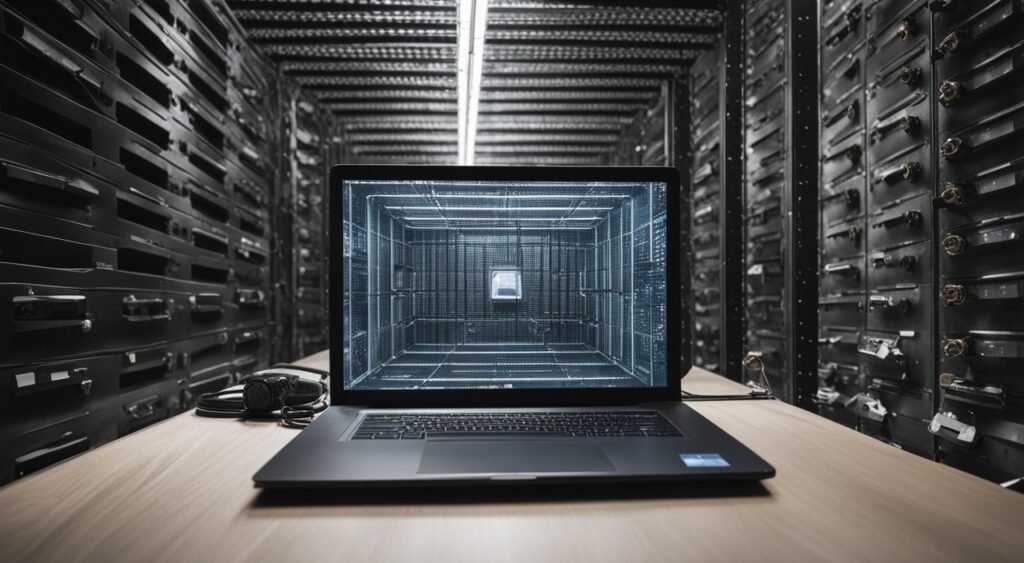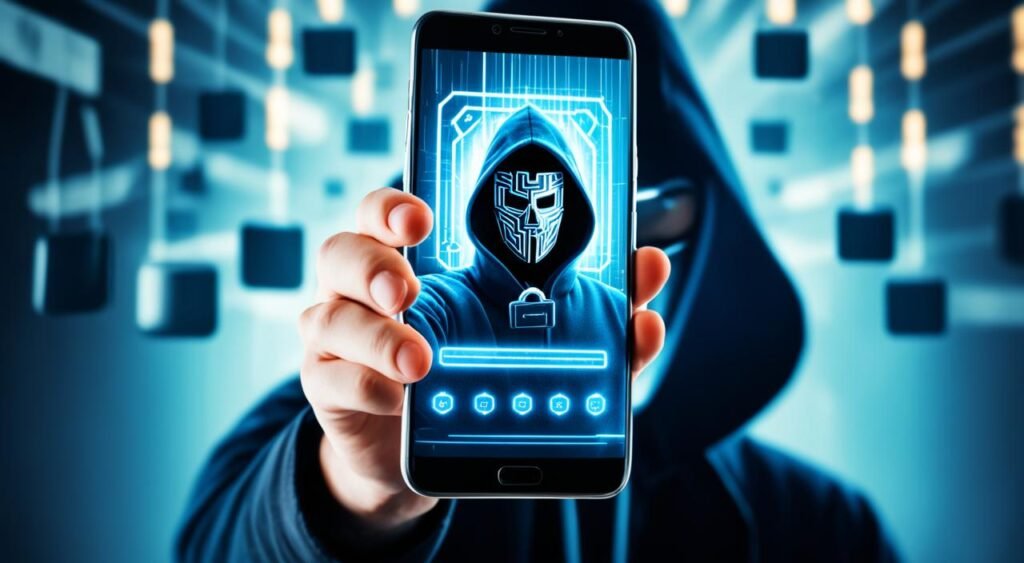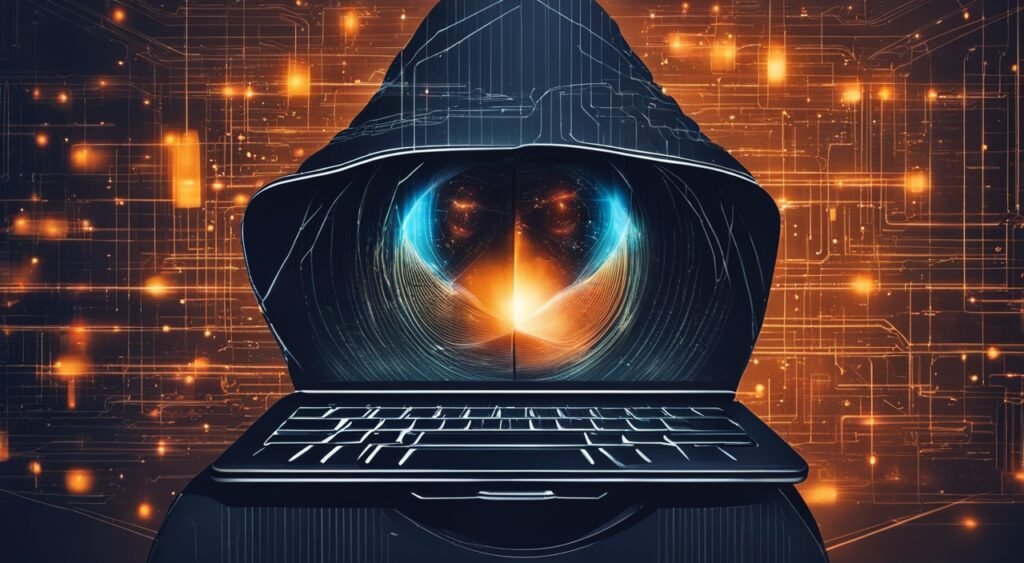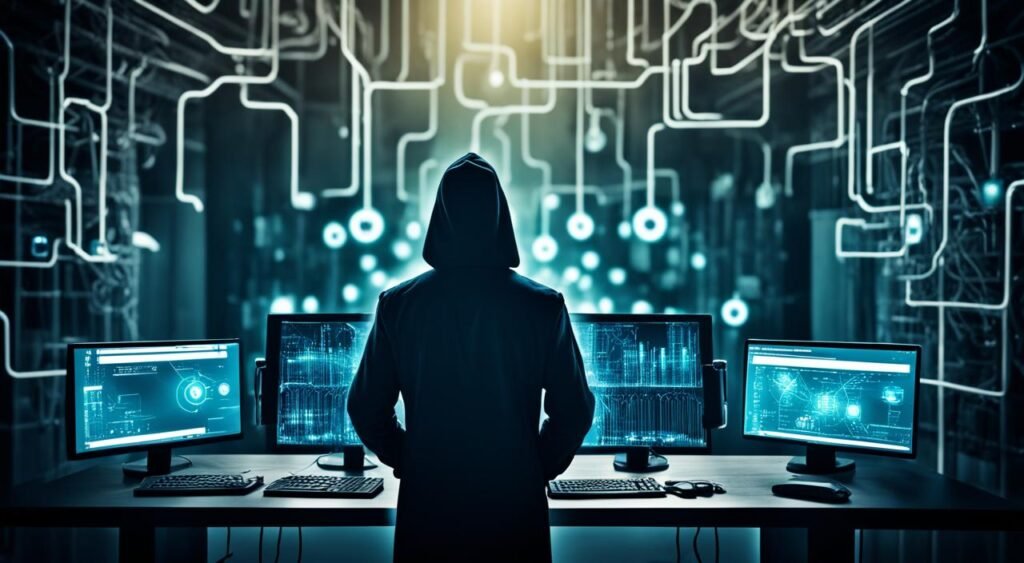In our connected world, cybersecurity is crucial. It keeps systems and data safe from cyber threats. By 2020, it’s expected we’ll have 20 to 30 billion devices connected to the Internet. This makes it easier for hackers to get user information illegally. They use this info for crimes like theft.
To stay safe from these risks, both people and companies need to act. They should update software and use good antivirus programs. It’s also important to have strong passwords and turn on extra protection like two-factor login. Plus, maintaining a clean digital space is key. Implementing well-rounded security measures is essential for protecting their online spaces.
Knowing about cyber threats and following the best practices can lower the danger. Having a strong cybersecurity program in place is key. This helps both groups and individuals be more secure online. It’s also important to keep learning and working together in the cybersecurity community. This is how we tackle future challenges wisely.
Key Takeaways
- Cybersecurity is essential for protecting against the growing threat of hacking and cyber attacks.
- Implementing best practices, such as keeping software updated and using strong passwords, can help prevent successful cyber attacks.
- Businesses must take a comprehensive approach to cybersecurity, including employee training, endpoint protection, and access management.
- Government agencies and organizations play a vital role in providing cybersecurity resources and guidance to support the broader community.
- Continuous learning and skills development within the cybersecurity field are crucial for staying ahead of emerging threats.
Understanding Hacking and Cyberthreats
Cybersecurity pros need to always watch out for new hacking methods. Hacking means getting into devices or systems without permission. The goal is often to steal personal info or make systems stop working. This kind of attack can lead to identity theft, fraud, or extortion. It’s a huge risk for everyone.
Types of Cyber Attacks
Cyber attacks come in many forms. There’s malware, phishing, spamming, and more. Hackers use trojans and viruses, or may even try to slow down a website with a denial-of-service attack. In these attacks, they can steal important information or mess up websites. Such cyber incidents lead to data breaches and cyber risk, risking people and companies.
Common Hacking Methods
Hackers have several tricks up their sleeves. They might secretly watch what users are doing with spyware. Or, they could trick someone into clicking a dangerous link. Sometimes, they find holes in systems’ defenses to get in. Learning about these methods is key to stop cyber attacks. It helps in building strong cybersecurity defenses against threats like ransomware.
Protecting Computers and Laptops

In today’s world, keeping our computers and laptops safe from online threats is critical. We need to use strong cybersecurity methods. This way, we lower the chances of being targeted by attackers online. Here are three main steps to help keep our devices and private data secure.
Keep Software Updated
It’s vital to keep our computer’s software and operating system current. This means updating them with the latest security features and patches. These updates fix any weaknesses that could be used by online criminals. By doing this regularly, our devices have better protection against cyber threats.
Install Antivirus and Antimalware
Having good antivirus and antimalware is another key part of safeguarding our computers and laptops. They can find and stop harmful software like viruses and scams. It’s important to update these security tools often and run checks with them. This can catch any dangerous threats early.
Disable Unused Connections
Turning off any connections like WiFi and Bluetooth when we’re not using them is smart. It closes off doors for hackers and keeps our devices safer. By keeping an eye on what’s connected to our technology, we improve our cybersecurity efforts.
Safeguarding Mobile Devices

Today, ensuring mobile device security is crucial. Users must take steps to protect their smartphones and tablets. Using strong passcodes or biometric methods, like fingerprints or facial recognition, guards against unauthorized use.
Use Strong Passcodes
A strong passcode keeps intruders out. It’s wise to avoid simple codes like birth dates. Instead, make up complex codes mixing numbers, letters, and symbols. This boosts your mobile device’s cybersecurity greatly.
Install Trusted Apps Only
Choosing the right mobile apps is important for mobile device security. Only download apps from reputable places like official stores. Be careful when apps ask for permissions. Malware or spyware in apps can harm your device’s security and privacy, exposing it to risks.
Update Mobile Software Regularly
Regular software updates are key to keeping your mobile operating system safe. These updates fix known issues and fight off new threats. Set your device to update automatically or check for updates often to stay protected.
Also Read :Protect Your Future with Technology Insurance
Securing Other Internet-Connected Devices

The Internet of Things (IoT) is growing fast. Experts predict 20-30 billion connected gadgets by 2020. This makes strong cybersecurity vital, not just for our computers and phones. It’s also key for keeping smart home gear and internet-connected devices safe from hackers who might try to get into your home network to steal important data.
Renaming devices and your network is an important first step. This includes changing device names and network names (SSID) from their default settings. It helps to hide your smart devices from cyber criminals. Also, set up strong and unique passwords for each device and your router. This makes it harder for unauthorized people to get in.
It’s crucial to keep your router safe by updating its firmware and setting solid security options. This protects your network and everything linked to it. Do the same for smart appliances. Ensure they’re up-to-date and secured by using strong passwords. This keeps your network safer from being invaded through these smart tools.
Putting cybersecurity first for all your internet-connected devices at home or small office helps a lot. It lowers the chance of hackers getting into your devices or stealing your info. It also helps stop them from using your devices for bad purposes.
cybersecurity Best Practices for Online Accounts

Keeping your online accounts safe is more important than ever. By following a few key cybersecurity rules, you can make sure your online account security improves. This includes keeping your email security and password security tight for both personal and work accounts.
Delete Suspicious Emails
Being careful with emails is crucial to stop phishing and spam attacks. If you get a dodgy email asking for important info or urgent action, just delete it. Opening these can harm your account access and open you up to scams or identity theft.
Use Secure Devices and Connections
Only log into your accounts from safe devices and connections, like your phone or personal computer. Public WiFi is risky because it can let others see your data. This opens the door to theft of your login details or worse.
Create Strong, Unique Passwords
Make your passwords strong by mixing up numbers, letters, and special characters. Steer clear of obvious choices. A password manager can help keep track of all your unique passwords, ensuring password security is top-notch.
Enable Multifactor Authentication
Turn on multifactor authentication where you can. It asks for a second way to prove it’s really you, like a code sent to your phone. This way, even if someone gets your password, they still can’t get in without the extra verification.
Be Cautious with Saved Information
Don’t save important financial info in your browser or apps. It’s convenient but very risky. If someone gets your device, they could easily misuse that info.
Sign Up for Account Alerts
Get account alerts from your online services. They can warn you if something fishy is happening with your account, like someone trying to log in without your permission. With alerts, you can react fast and keep your account safe.
Responding to Hacked Devices or Accounts
If your device or online account gets hacked, it’s key to act fast. You need to protect your info and stop more damage. The first thing to do is get a cybersecurity specialist or a technical support expert to check your device. They will look for any malware and help remove it.
Have Devices Inspected
After finding a breach, having your devices checked is a must. Computers, laptops, or phones should all be looked at by pros. They use tools to find and delete any malware. This makes sure your device is safe from more harm.
Change Compromised Passwords
It’s also important to change your passwords if they were compromised. This stops the attacker from using your accounts to do harm. Always use strong, different passwords for every account. This helps keep your cybersecurity strong and protects you from data breaches.
Importance of Cyber Hygiene
Staying safe from cyber threats is more crucial than ever. Good “cyber hygiene” involves using best practices to enhance our security. It helps us guard against many cyber attacks.
Multifactor Authentication
Setting up multifactor authentication (MFA) is highly effective. It adds another step to verify your identity, making it harder for hackers to get in. This step is important for keeping our private data safe.
Software Updates
It’s vital to keep all our software up-to-date with the latest security fixes. Updates often close doors that hackers might use. Regularly updating our systems helps make us less vulnerable to attacks.
Think Before Clicking Links
Phishing attacks are still a big problem. We must be careful when we get emails or messages with links or attachments. Checking if they’re really from a trusted source can save us from getting hacked.
Use Strong Passwords
Creating strong, unique passwords for each account is key. We should avoid using easy-to-guess information. Strong passwords help protect our accounts and the information within them.
Following these security best practices enhances our cyber hygiene. It lowers our risk of being targeted in a cyber attack. By doing so, we keep our important data secure.
Comprehensive Cybersecurity Measures for Businesses

Businesses must stay ahead of threats by using a broad cybersecurity plan. This plan should cover many areas to strengthen defenses. Improved enterprise security helps keep important information safe.
Employee Training
Training employees is key to a strong business cybersecurity. It helps them spot and deal with cyber threats, lowering the chance of attacks.
Software and System Updates
Always update your software and systems to stay secure. New updates usually fix known problems, making it harder for hackers to get in.
Endpoint Protection
Using antivirus and firewalls on devices makes a strong line of defense. These tools stop cyber incidents at the spot where they might begin.
Firewalls
Firewalls at the network level stop unwanted cyber threats and check traffic. Keeping these firewalls updated is vital for good enterprise security.
Data Backup
Backing up data often is critical. It means that if there’s a cyber attack, you can recover quickly. This is important to keep your business running smoothly.
Access Control
Control who can reach your important systems and data. Access control is a big part of keeping your enterprise security tight.
WiFi Security
Secure your organization’s WiFi to stop cyber threats. Use safe practices and update your network to keep hackers out.
Access Management
Manage who has access to your systems carefully. By staying on top of user accounts, you avoid letting the wrong people in. This reduces cyber incident risks.
Password Policies
Set tough rules for passwords and how they’re used. This scheme makes enterprise systems safer. It fights off cyber threats that target passwords.
| Cybersecurity Measure | Description | Benefits |
|---|---|---|
| Employee Training | Providing comprehensive cybersecurity training to employees to enhance their ability to identify and respond to potential threats. | Reduces the risk of successful cyber attacks by empowering employees to be the first line of defense. |
| Software and System Updates | Ensuring all software and systems are kept up-to-date with the latest security patches to address known vulnerabilities. | Mitigates the risk of successful exploits by closing security gaps and enhancing overall enterprise security. |
| Endpoint Protection | Implementing antivirus, antimalware, and firewall solutions to safeguard individual devices and the network. | Provides a multi-layered defense against cyber threats, detecting and preventing malicious activity at the endpoint level. |
| Firewalls | Deploying and maintaining network-level firewalls to control and monitor traffic, blocking unauthorized access. | Establishes a critical security barrier to prevent cyber attacks from penetrating the network and accessing sensitive data. |
| Data Backup | Regularly backing up critical data and systems to ensure business continuity and rapid recovery in the event of a cyber incident. | Enables the organization to quickly restore operations and minimize the impact of successful cyber attacks, such as ransomware. |
| Access Control | Implementing robust user authentication, authorization, and privilege management to prevent unauthorized access. | Restricts access to sensitive systems and data, reducing the risk of cyber threats exploiting vulnerabilities. |
| WiFi Security | Securing the organization’s wireless network to prevent cyber threats from exploiting vulnerabilities and gaining access. | Enhances the overall enterprise security by denying attackers a potential entry point into the network. |
| Access Management | Establishing policies and procedures to manage user accounts, including timely provisioning and de-provisioning. | Prevents unauthorized access and minimizes the risk of cyber incidents resulting from compromised or abandoned user accounts. |
| Password Policies | Enforcing strong password requirements, including complexity, uniqueness, and regular changes, along with multi-factor authentication. | Significantly enhances the security of enterprise systems and online accounts, protecting against password-related cyber threats. |
Role of Government and Organizations
In the United States, is strongly supported by government and groups. They help raise awareness and set up standards. These actions aim to protect important systems and the general public.
CISA Cybersecurity Resources
The Cybersecurity and Infrastructure Security Agency (CISA) is a key part of the Homeland Security Department. It provides a wide range of resources and advice. CISA’s work helps improve the situation of the whole country.
NIST Cybersecurity Framework
The National Institute of Standards and Technology (NIST) created the NIST Framework. It’s a popular guide for making better. It offers ways for organizations to check and handle risks well.
Homeland Security Initiatives
Besides CISA, the Department of Homeland Security (DHS) runs several programs for better . They focus on keeping critical systems safe. DHS works with both public and private groups to fight new risks. This aims to make important services more resilient.
Future of Cybersecurity
The world of cybersecurity is always changing. To keep up, both organizations and individuals need to stay alert. They must watch out for new cyber threats. This requires using the latest security technology. It also means always learning and improving in the field of cybersecurity.
Emerging Threats
The dangers in cybersecurity keep getting more complex. Attackers use new methods all the time. They might target AI security, machine learning security, or cloud security. Defending against these will need a smart, flexible strategy.
Advancements in Security Technology
Cyber attacks have become more sophisticated. The future fight against them will heavily use new tech. This includes security automation, AI security, and machine learning security. Stronger cloud security measures will also improve data protection.
Importance of Continuous Learning
Learning about cybersecurity and keeping your skills sharp is vital. For both people and businesses, ongoing education is key. It prepares them for the new threats and tech that are always appearing. This helps maintain cyber resilience.
Conclusion
Cybersecurity is key to protect against hacking and cyber attacks. By knowing different types of cyber threats, you can lower the risk. This makes your cyber resilience stronger. Using a solid cybersecurity strategy is very important now.
Keeping software updated, using unique passwords, and adding extra login steps help stop cyber attacks. Always learning about new threats and staying watchful are crucial. They help guard against cyber risks in the future.
The digital world is always growing. So, cybersecurity is more important than ever. Taking a proactive and thorough approach helps individuals and groups stay safe. It keeps important data away from bad actors. This improves security and resilience against changing cyber threats.
FAQs
In our connected world, cybersecurity is crucial. It keeps systems and data safe from cyber threats. By 2020, it’s expected we’ll have 20 to 30 billion devices connected to the Internet. This makes it easier for hackers to get user information illegally. They use this info for crimes like theft.
To stay safe from these risks, both people and companies need to act. They should update software and use good antivirus programs. It’s also important to have strong passwords and turn on extra protection like two-factor login. Plus, maintaining a clean digital space is key. Implementing well-rounded security measures is essential for protecting their online spaces.
Knowing about cyber threats and following the best practices can lower the danger. Having a strong cybersecurity program in place is key. This helps both groups and individuals be more secure online. It’s also important to keep learning and working together in the cybersecurity community. This is how we tackle future challenges wisely.
Key Takeaways
- Cybersecurity is essential for protecting against the growing threat of hacking and cyber attacks.
- Implementing best practices, such as keeping software updated and using strong passwords, can help prevent successful cyber attacks.
- Businesses must take a comprehensive approach to cybersecurity, including employee training, endpoint protection, and access management.
- Government agencies and organizations play a vital role in providing cybersecurity resources and guidance to support the broader community.
- Continuous learning and skills development within the cybersecurity field are crucial for staying ahead of emerging threats.
Understanding Hacking and Cyberthreats
Cybersecurity pros need to always watch out for new hacking methods. Hacking means getting into devices or systems without permission. The goal is often to steal personal info or make systems stop working. This kind of attack can lead to identity theft, fraud, or extortion. It’s a huge risk for everyone.
Types of Cyber Attacks
Cyber attacks come in many forms. There’s malware, phishing, spamming, and more. Hackers use trojans and viruses, or may even try to slow down a website with a denial-of-service attack. In these attacks, they can steal important information or mess up websites. Such cyber incidents lead to data breaches and cyber risk, risking people and companies.
Common Hacking Methods
Hackers have several tricks up their sleeves. They might secretly watch what users are doing with spyware. Or, they could trick someone into clicking a dangerous link. Sometimes, they find holes in systems’ defenses to get in. Learning about these methods is key to stop cyber attacks. It helps in building strong cybersecurity defenses against threats like ransomware.
Protecting Computers and Laptops

In today’s world, keeping our computers and laptops safe from online threats is critical. We need to use strong cybersecurity methods. This way, we lower the chances of being targeted by attackers online. Here are three main steps to help keep our devices and private data secure.
Keep Software Updated
It’s vital to keep our computer’s software and operating system current. This means updating them with the latest security features and patches. These updates fix any weaknesses that could be used by online criminals. By doing this regularly, our devices have better protection against cyber threats.
Install Antivirus and Antimalware
Having good antivirus and antimalware is another key part of safeguarding our computers and laptops. They can find and stop harmful software like viruses and scams. It’s important to update these security tools often and run checks with them. This can catch any dangerous threats early.
Disable Unused Connections
Turning off any connections like WiFi and Bluetooth when we’re not using them is smart. It closes off doors for hackers and keeps our devices safer. By keeping an eye on what’s connected to our technology, we improve our cybersecurity efforts.
Safeguarding Mobile Devices

Today, ensuring mobile device security is crucial. Users must take steps to protect their smartphones and tablets. Using strong passcodes or biometric methods, like fingerprints or facial recognition, guards against unauthorized use.
Use Strong Passcodes
A strong passcode keeps intruders out. It’s wise to avoid simple codes like birth dates. Instead, make up complex codes mixing numbers, letters, and symbols. This boosts your mobile device’s cybersecurity greatly.
Install Trusted Apps Only
Choosing the right mobile apps is important for mobile device security. Only download apps from reputable places like official stores. Be careful when apps ask for permissions. Malware or spyware in apps can harm your device’s security and privacy, exposing it to risks.
Update Mobile Software Regularly
Regular software updates are key to keeping your mobile operating system safe. These updates fix known issues and fight off new threats. Set your device to update automatically or check for updates often to stay protected.
Also Read :Protect Your Future with Technology Insurance
Securing Other Internet-Connected Devices

The Internet of Things (IoT) is growing fast. Experts predict 20-30 billion connected gadgets by 2020. This makes strong cybersecurity vital, not just for our computers and phones. It’s also key for keeping smart home gear and internet-connected devices safe from hackers who might try to get into your home network to steal important data.
Renaming devices and your network is an important first step. This includes changing device names and network names (SSID) from their default settings. It helps to hide your smart devices from cyber criminals. Also, set up strong and unique passwords for each device and your router. This makes it harder for unauthorized people to get in.
It’s crucial to keep your router safe by updating its firmware and setting solid security options. This protects your network and everything linked to it. Do the same for smart appliances. Ensure they’re up-to-date and secured by using strong passwords. This keeps your network safer from being invaded through these smart tools.
Putting cybersecurity first for all your internet-connected devices at home or small office helps a lot. It lowers the chance of hackers getting into your devices or stealing your info. It also helps stop them from using your devices for bad purposes.
cybersecurity Best Practices for Online Accounts

Keeping your online accounts safe is more important than ever. By following a few key cybersecurity rules, you can make sure your online account security improves. This includes keeping your email security and password security tight for both personal and work accounts.
Delete Suspicious Emails
Being careful with emails is crucial to stop phishing and spam attacks. If you get a dodgy email asking for important info or urgent action, just delete it. Opening these can harm your account access and open you up to scams or identity theft.
Use Secure Devices and Connections
Only log into your accounts from safe devices and connections, like your phone or personal computer. Public WiFi is risky because it can let others see your data. This opens the door to theft of your login details or worse.
Create Strong, Unique Passwords
Make your passwords strong by mixing up numbers, letters, and special characters. Steer clear of obvious choices. A password manager can help keep track of all your unique passwords, ensuring password security is top-notch.
Enable Multifactor Authentication
Turn on multifactor authentication where you can. It asks for a second way to prove it’s really you, like a code sent to your phone. This way, even if someone gets your password, they still can’t get in without the extra verification.
Be Cautious with Saved Information
Don’t save important financial info in your browser or apps. It’s convenient but very risky. If someone gets your device, they could easily misuse that info.
Sign Up for Account Alerts
Get account alerts from your online services. They can warn you if something fishy is happening with your account, like someone trying to log in without your permission. With alerts, you can react fast and keep your account safe.
Responding to Hacked Devices or Accounts
If your device or online account gets hacked, it’s key to act fast. You need to protect your info and stop more damage. The first thing to do is get a cybersecurity specialist or a technical support expert to check your device. They will look for any malware and help remove it.
Have Devices Inspected
After finding a breach, having your devices checked is a must. Computers, laptops, or phones should all be looked at by pros. They use tools to find and delete any malware. This makes sure your device is safe from more harm.
Change Compromised Passwords
It’s also important to change your passwords if they were compromised. This stops the attacker from using your accounts to do harm. Always use strong, different passwords for every account. This helps keep your cybersecurity strong and protects you from data breaches.
Importance of Cyber Hygiene
Staying safe from cyber threats is more crucial than ever. Good “cyber hygiene” involves using best practices to enhance our security. It helps us guard against many cyber attacks.
Multifactor Authentication
Setting up multifactor authentication (MFA) is highly effective. It adds another step to verify your identity, making it harder for hackers to get in. This step is important for keeping our private data safe.
Software Updates
It’s vital to keep all our software up-to-date with the latest security fixes. Updates often close doors that hackers might use. Regularly updating our systems helps make us less vulnerable to attacks.
Think Before Clicking Links
Phishing attacks are still a big problem. We must be careful when we get emails or messages with links or attachments. Checking if they’re really from a trusted source can save us from getting hacked.
Use Strong Passwords
Creating strong, unique passwords for each account is key. We should avoid using easy-to-guess information. Strong passwords help protect our accounts and the information within them.
Following these security best practices enhances our cyber hygiene. It lowers our risk of being targeted in a cyber attack. By doing so, we keep our important data secure.
Comprehensive Cybersecurity Measures for Businesses

Businesses must stay ahead of threats by using a broad cybersecurity plan. This plan should cover many areas to strengthen defenses. Improved enterprise security helps keep important information safe.
Employee Training
Training employees is key to a strong business cybersecurity. It helps them spot and deal with cyber threats, lowering the chance of attacks.
Software and System Updates
Always update your software and systems to stay secure. New updates usually fix known problems, making it harder for hackers to get in.
Endpoint Protection
Using antivirus and firewalls on devices makes a strong line of defense. These tools stop cyber incidents at the spot where they might begin.
Firewalls
Firewalls at the network level stop unwanted cyber threats and check traffic. Keeping these firewalls updated is vital for good enterprise security.
Data Backup
Backing up data often is critical. It means that if there’s a cyber attack, you can recover quickly. This is important to keep your business running smoothly.
Access Control
Control who can reach your important systems and data. Access control is a big part of keeping your enterprise security tight.
WiFi Security
Secure your organization’s WiFi to stop cyber threats. Use safe practices and update your network to keep hackers out.
Access Management
Manage who has access to your systems carefully. By staying on top of user accounts, you avoid letting the wrong people in. This reduces cyber incident risks.
Password Policies
Set tough rules for passwords and how they’re used. This scheme makes enterprise systems safer. It fights off cyber threats that target passwords.
| Cybersecurity Measure | Description | Benefits |
|---|---|---|
| Employee Training | Providing comprehensive cybersecurity training to employees to enhance their ability to identify and respond to potential threats. | Reduces the risk of successful cyber attacks by empowering employees to be the first line of defense. |
| Software and System Updates | Ensuring all software and systems are kept up-to-date with the latest security patches to address known vulnerabilities. | Mitigates the risk of successful exploits by closing security gaps and enhancing overall enterprise security. |
| Endpoint Protection | Implementing antivirus, antimalware, and firewall solutions to safeguard individual devices and the network. | Provides a multi-layered defense against cyber threats, detecting and preventing malicious activity at the endpoint level. |
| Firewalls | Deploying and maintaining network-level firewalls to control and monitor traffic, blocking unauthorized access. | Establishes a critical security barrier to prevent cyber attacks from penetrating the network and accessing sensitive data. |
| Data Backup | Regularly backing up critical data and systems to ensure business continuity and rapid recovery in the event of a cyber incident. | Enables the organization to quickly restore operations and minimize the impact of successful cyber attacks, such as ransomware. |
| Access Control | Implementing robust user authentication, authorization, and privilege management to prevent unauthorized access. | Restricts access to sensitive systems and data, reducing the risk of cyber threats exploiting vulnerabilities. |
| WiFi Security | Securing the organization’s wireless network to prevent cyber threats from exploiting vulnerabilities and gaining access. | Enhances the overall enterprise security by denying attackers a potential entry point into the network. |
| Access Management | Establishing policies and procedures to manage user accounts, including timely provisioning and de-provisioning. | Prevents unauthorized access and minimizes the risk of cyber incidents resulting from compromised or abandoned user accounts. |
| Password Policies | Enforcing strong password requirements, including complexity, uniqueness, and regular changes, along with multi-factor authentication. | Significantly enhances the security of enterprise systems and online accounts, protecting against password-related cyber threats. |
Role of Government and Organizations
In the United States, is strongly supported by government and groups. They help raise awareness and set up standards. These actions aim to protect important systems and the general public.
CISA Cybersecurity Resources
The Cybersecurity and Infrastructure Security Agency (CISA) is a key part of the Homeland Security Department. It provides a wide range of resources and advice. CISA’s work helps improve the situation of the whole country.
NIST Cybersecurity Framework
The National Institute of Standards and Technology (NIST) created the NIST Framework. It’s a popular guide for making better. It offers ways for organizations to check and handle risks well.
Homeland Security Initiatives
Besides CISA, the Department of Homeland Security (DHS) runs several programs for better . They focus on keeping critical systems safe. DHS works with both public and private groups to fight new risks. This aims to make important services more resilient.
Future of Cybersecurity
The world of cybersecurity is always changing. To keep up, both organizations and individuals need to stay alert. They must watch out for new cyber threats. This requires using the latest security technology. It also means always learning and improving in the field of cybersecurity.
Emerging Threats
The dangers in cybersecurity keep getting more complex. Attackers use new methods all the time. They might target AI security, machine learning security, or cloud security. Defending against these will need a smart, flexible strategy.
Advancements in Security Technology
Cyber attacks have become more sophisticated. The future fight against them will heavily use new tech. This includes security automation, AI security, and machine learning security. Stronger cloud security measures will also improve data protection.
Importance of Continuous Learning
Learning about cybersecurity and keeping your skills sharp is vital. For both people and businesses, ongoing education is key. It prepares them for the new threats and tech that are always appearing. This helps maintain cyber resilience.
Conclusion
Cybersecurity is key to protect against hacking and cyber attacks. By knowing different types of cyber threats, you can lower the risk. This makes your cyber resilience stronger. Using a solid cybersecurity strategy is very important now.
Keeping software updated, using unique passwords, and adding extra login steps help stop cyber attacks. Always learning about new threats and staying watchful are crucial. They help guard against cyber risks in the future.
The digital world is always growing. So, cybersecurity is more important than ever. Taking a proactive and thorough approach helps individuals and groups stay safe. It keeps important data away from bad actors. This improves security and resilience against changing cyber threats.
FAQs
Q: What is cybersecurity and how can it prevent hacking?
A: Cybersecurity refers to the practice of protecting systems, networks, and programs from digital attacks. It encompasses various technologies, processes, and practices that are designed to safeguard sensitive information and prevent unauthorized access. By implementing cybersecurity measures such as network security, endpoint security, and application security, organizations can significantly reduce the risk of cyberattacks and hacking incidents.
Q: What are the common types of cybersecurity used to prevent hacking?
A: There are several types of cybersecurity that organizations use to protect their systems and data. Some common types include network security, endpoint security, application security, and identity and access management. Each type plays a crucial role in strengthening the overall cybersecurity posture of an organization and mitigating cyber threats.
Q: How can cybersecurity assessments help in preventing hacking?
A: Cybersecurity assessments are essential for organizations to evaluate their existing security measures, identify vulnerabilities, and gaps, and develop a comprehensive security strategy. By conducting regular assessments, organizations can proactively address potential security risks and strengthen their cybersecurity defenses, thus reducing the likelihood of successful hacking attempts.
Q: Why is cybersecurity training important in preventing hacking incidents?
A: Cybersecurity training is crucial for raising awareness among employees about the importance of security practices and the potential risks posed by cyber threats. By providing employees with security awareness training, organizations can empower them to identify and report suspicious activities, adhere to security best practices, and prevent unintentional actions that could lead to hacking incidents.
Q: How do cybersecurity solutions contribute to preventing hacking?
A: Cybersecurity solutions encompass a range of tools, technologies, and practices that are designed to protect systems, networks, and data from cyber threats. By implementing security solutions such as firewalls, antivirus software, encryption, and intrusion detection systems, organizations can enhance their security posture and prevent hacking incidents effectively.
Q: What are some common cybersecurity threats that organizations should be aware of to prevent hacking?
A: Organizations should be vigilant against various cybersecurity threats, including ransomware attacks, malicious software, data breaches, and social engineering tactics. By understanding these threats and their potential impact, organizations can implement appropriate security measures to mitigate the risks and prevent successful hacking attempts.
Q: How can organizations secure their websites to prevent hacking?
A: To secure websites and prevent hacking incidents, organizations should implement security best practices such as keeping software up to date, using secure protocols (HTTPS), implementing web application firewalls, and conducting regular security audits. By prioritizing website security, organizations can protect sensitive information and maintain the trust of their users.
Source Links
Source Links
- https://www.cisa.gov/news-events/news/4-things-you-can-do-keep-yourself-cyber-safe
- https://www.ag.state.mn.us/consumer/publications/HowtoProtectYourselfAgainstHackers.asp
- https://leaf-it.com/10-ways-prevent-cyber-attacks/




